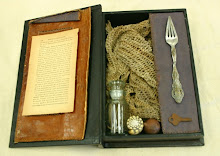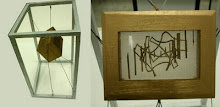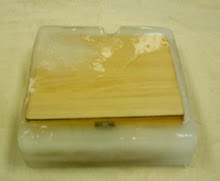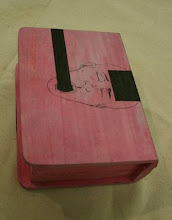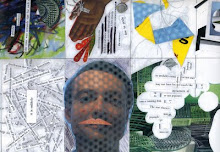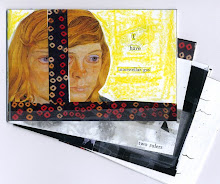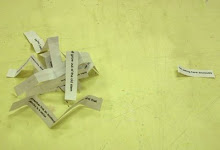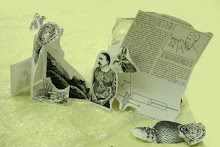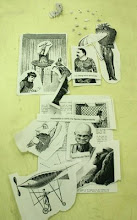My eight-year-old son Troy came with us, and he was a good museum companion. He put his face up to the AbEx paintings in order to immerse himself in their canvases, side-stepping back and forth to observe how the colors in front of his eyes changed. He loved the various assemblages, he was disturbed by Victor Brauner's Suicide at Dawn, and he was told by a museum worker to stop running as he wound his way around Richard Serra's Bend and Sequence. He also thought the Mondrian-inspired chair was neat, and he was amused by the gigantic litter box. ("Lucy [our cat] would love this!") He was not as taken with Jeff Koons's balloon dog or floating basketballs or giant eggshell, though we did make a joke about how the balloon dog may have been born from that egg. When he saw Quad Elvis, he asked, "Why would that woman agree to be naked like that?" And then, "Wouldn't she be embarrassed to have everyone see her naked in a museum?"
VVP: Art 434 & Engl. 410
- Dan Callis and Chris Davidson
- Website for Vision Voice and Practice: An Interdisciplinary Course in Art and Creative Writing
Monday, March 28, 2011
Went to LACMA
The class went to LACMA yesterday, where we looked at a pair of Joseph Cornell boxes. Then, standing in front of the massive Robert Motherwell canvas (absurdly tiny in the link), we listened as Dan read to us excerpts from a correspondence between Motherwell and the poet Frank O'Hara. Talking about it afterwards, Dan and I agreed that we should have given the students some sort of task after our brief foray into Sound + Vision, but we weren't sure what it would have been. At any rate, seeing the stuff in person is always better than in a book or on a screen, as I was reminded by looking at the museum's enchanting Mondrian, with its marble-like cracks and expressive brush strokes, which are invisible in reproduction.
Monday, March 21, 2011
Matter and Spirit: An Exhibition
Mary Ellen Long's books

 Mary Ellen Long's relationship to book is unique in the way it expresses her relationship between earth and spirit in a very physical way. She displays three books that were without covers and damaged to the point where they were all unreadable and held together by three cords of wrapped wire. The books had been left to the elements and as a result their appearance was decayed, fragile, almost romantically beautiful. These books had been part of an installation, a performance work and now are presented as sculpture. By removing the binding, and replacing it with wire, she was able to seal and bury the book and let natural corrosion take place. The installation portion of this work reads as a sort of funeral. She releases the book (along with its original content) to nature and in turn nature acts on it. It (nature) both acts on the text and well as reads the book. One finds one self asking if the original content was still there in the physical aspect of the book or did it leave the book along with the ability to read it? Samantha Leaden, Chelsea Almeter
Mary Ellen Long's relationship to book is unique in the way it expresses her relationship between earth and spirit in a very physical way. She displays three books that were without covers and damaged to the point where they were all unreadable and held together by three cords of wrapped wire. The books had been left to the elements and as a result their appearance was decayed, fragile, almost romantically beautiful. These books had been part of an installation, a performance work and now are presented as sculpture. By removing the binding, and replacing it with wire, she was able to seal and bury the book and let natural corrosion take place. The installation portion of this work reads as a sort of funeral. She releases the book (along with its original content) to nature and in turn nature acts on it. It (nature) both acts on the text and well as reads the book. One finds one self asking if the original content was still there in the physical aspect of the book or did it leave the book along with the ability to read it? Samantha Leaden, Chelsea Almeter
Linda Ekstrom's Tendrils & Truck




Top images: Trunk
Bottom images: Tendrils
When considering the power of the written word, one must also be keenly aware of the way in which the medium of a book affects the way in which an audience approaches the material within its covers. Although the text found in a magazine, a newspaper or a bound-book might be similar in content, they each invite the reader to interpret the information presented in often vastly distinct ways. Many of the works on display in the Biola Library's show Matter and Spirit, demonstrate the artists' exploration of the physicality or spirituality of matter or the intellectual or emotional weight of a chosen subject matter through a variety of media. While many of the pieces utilize video, multimedia, drawing or print, several artists chose to explore the show's themes through the utilization of books as their sculptural medium.
Linda Ekstrom, manipulated the same text repeatedly in order to create new meaning in each piece. Ekstrom often represents the kinesthetic energy of book, in which the movement of the materials is meant to symbolize the manner in which books extend beyond the confines of the page and interact with our ways of thinking and being. There are two particular pieces that created intriguing visual statements: one was called Tendrils and the other entitled Trunk. The
piece Tendrils, composed entirely out of the pages of the prophets of the Old Textament, is a series of wrapped cords that are suspended within their case in order to allow the trails of paper to coil downward like the roots of a plant or sprouts of a vine. This technique creates both a visually compelling and mystifying effect, but also allows for a rich "reading" of the piece as the way in which Christians view the Old Testament prophets. In contrast, Ekstroms's piece,Trunk, does not possess the same visual movement found in Tendrils, and instead uses an entire Bible, rolled and bound in gold thread, to fashion a small, round column. This piece does not lack interest, as its description might suggest, since the way in which the pages fan in contrast with the wandering gold thread along the perimeter generates an active visual gesture, albeit in a highly distinct manner from the cords of Tendrils. The structures and titles of both
pieces evoke the rich botanical metaphors found with in Scripture, while remaining sufficiently abstract so that one does not feel overpowered by the artist's meaning. Amanda Rountree
New Collaborations
Sunday, March 20, 2011
Speaking as Making
Still, the word has power to create. When God speaks, God creates. When God says, "Let there be light," light is. God speaks light. For God, speaking and creating are the same. It is this creative power of the word we need to reclaim. What we say is very important. When we say, "I love you," and say it from the heart, we can give another person new life, new hope, new courage. When we say, "I hate you," we can destroy another person. Let's watch our words.
- Henri Nouwen
Metaphor as Mistake
We read the terrific essay "Metaphor as Mistake," by Walker Percy, earlier in the semester, and I came across this last week:
I like hearing things incorrectly. I think that’s how I get a lot of ideas is by mishearing something.
Sonic Youth also make music based on mishearings, on accidents they (paradox!) actively cultivate, though the records fix in sound the resulting experiments, much as an improvised jazz composition gets fixed on vinyl. Greil Marcus, writing about Sonic Youth bootlegs, points up the difference between hearing Sonic Youth's songs, repeatable through speakers, and the live, unrepeatable experience:
The bootleg tapes can't capture the complexity, or define the intentions or accidents, of a moment in which Sonic Youth makes a room fly apart, but they can capture the band's negating influence, its will to function as a sort of sonic corrosive...
This last clause suggests the value of the made thing, imperfect though it may be in capturing the totality of the entity that made it. Just as no poem can capture everything about the poet--or the poet's process--we remain grateful for the poem we get. SY is, of course, influenced by the aleatory experiments of John Cage and others in the avant garde, whose work we have almost only via technology that "fixes" it. This is the problem, of course: assuming that the thing we get is the thing itself, completely. But if you don't make that mistake, you can enjoy the privilege of technology, which, gives us such artifacts as Kind of Blue, "The Steeple-Jack," and access to performances like this, at your fingertips.
Friday, March 4, 2011
Hurston / Hedberg
In class yesterday, we watched a Mitch Hedberg routine from the David Letterman show, different from the one above. A great thing about Hedberg is the care he puts into his jokes. Check out the structure of this punchline:
If the pizza was a pie chart for what people would do if they found a million dollars, this dude gave me the 'donate-it-to-charity' slice.
That's a pretty complicated sentence, crafted so that the laugh doesn't come until the very last word. Anyone who writes knows how hard that can be. Even the associations are strange, and strangely apt: He's making the weird (but, as it's said, instantly reasonable) claim that a pizza looks like a pie chart, and he relies on the audience's cultural knowledge of what a pie chart illustrating the attitudes of random people looks like. (They've seen it on T.V. They've seen it on the Internet.) The word "dude" in there keeps the joke tethered to the ground...unlike, perhaps, this analysis.
In an interview in 2004, not long before he died, Hedberg talked about the limitations of his own innate capabilities, and how he used those limitations to arrive at the kind of comedy he made:
The one-liner style, that came because I'm not a good storyteller. I would add on to a concept that I thought was funny but was getting no laughs, and I'd get more uptight. I decided to get to the point quicker, get rid of all the fat. When I tell a story, it's always been very much just the facts, so all my jokes are really stories that are broken down to the most factual sense.
This gift for (poetic) concision might be thought of as one of the things "stuffed into" the brown paper bag that is Mitch Hedberg--to borrow Zora Neale Hurston's metaphor from yesterday's reading. She, too, had certain gifts--of dance, say--that distinguish her from her own people (when performing for the white travelers passing through her childhood town), from her classmates at Barnard, and, later, from the white man who staidly sits at the club, listening to the jazz that takes hold of her and, both physically and emotionally, transports her. She says she's a "born first-nighter," a born performer. It's nothing she asked for. And she tells us she must use her gifts, despite the long odds society tells her she faces. She must work, and she does:
I am off to a flying start and I must not halt in the stretch to look behind and weep.Asked about how often he's working on new material, Hedberg replies,
Oh, all the time, man. I just got to start writing it out in full, though. Now I'm down to writing the shortest amount of buzzwords possible, hoping I'll remember it. It's hard to step backward from those words and say, "What did that mean? What do the words 'owl' and 'my dad' mean together?"

[Photograph by Prentis Taylor]
Thursday, March 3, 2011
Image/Text
VVP alum Melissa Gutierrez shared with me a link to an online journal, The Caterpillar Chronicles, which aims to create image/text-based artifacts, much like the stuff we're making in this class. At first blush, the journal seems like a(nother), conventional literary mag, but there is a collaborative intentionality at work in it that is easily missed if you skip over the editors' note at the beginning. The Image & Text project, we learn, collects poems inspired by--or written in response to--a particular photograph. Projects like these comprise the magazine's content. (And it reads like a magazine, too, with a beautiful interface.) My favorite thing, on first perusal, is Alexandra Magearu's "Thoughts About the End of the World," for which she provided both the words and images. It's an elegant, thoughtful piece.
Wednesday, March 2, 2011
Class Visitors

We've been fortunate to have three class visitors, Aimee Bender, Carrie Purcell, and Allison Benis White. Aimee talked about "practice," as in our course's title--particularly about getting to her writing work every day. (She writes five days a week, two hours a day.) Carrie Purcell talked to us about an amazing art/music/poetry project, called Formal Inquiry, she's putting together for a weekend of performances in June in Seattle. Would that we could take our entire class on a field trip there! And yesterday, Allison Benis White came and talked with us about the poems she's made using Degas paintings as a "way in." We have more visitors yet to come, which is exciting, but so far it's been a feast.
Subscribe to:
Comments (Atom)








































































